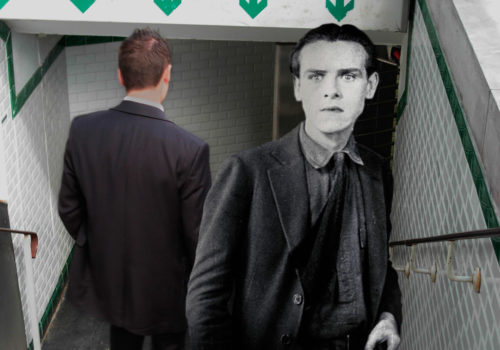Throughout her career, Aurélie Deplus, head of arts patronage at Société Générale since 2013, has embodied the place of the human at the heart of the Group’s collections which include over 300 original works and 700 lithographs. A financial analyst, she was among the first four collaborators selected to join the Art Acquisitions Committee and to work in tandem with an expert.
We are meeting Aurélie Deplus at the headquarters at la Défénse, while many employees are preparing to transfer in 2016 to Val de Fontenay to what looks like a futuristic campus.
While an exhibition by independent curator Koyo Kouoh is coming to an end—organized around the theme of displacement, financial flux, movement of people, and exploring the relation between the viewer and the work—and another installation, on the theme of music, is being prepared, we discover this peculiar space which represents both a constraint and a challenge. The artists featured in the collection include Soulages, Alechinsky, Zao Wou Ki, but also emerging artists, such as Morgane Tschiember, the Chevalme sisters, Farah Atassi, and Mathieu Mercier, representing one of the major trends since the mid-2000s and marking a turn toward photography. We also find Liu Biolin and his emblematic self-portrait taken in the bank vault at Boulevard Haussmann; Aleix Plademunt and his Espectadores; Eric Rondepierre at a metro exit; Pierre Gonnord and his models; Loan Nguyen and her contemplative landscapes; or Edouard Levé and his rugby players—very topical for a Group that turned the sport into one of its self-branding strategies.
How do you assess Société Générale’s approach to art over the past twenty years?
“There is a perceptible evolution in the way the Collection has been shared with the public. It was originally established for the benefit of the Group’s collaborators, but very quickly there emerged a desire to share it with museums and cultural institutions by way of one or two exhibitions a year, mostly in the provinces. Subsequently, we have focused on opening up towards and targeting both younger audiences and the general public (for two years now, by simple subscription on our website).”
To the question of gauging outside perception, despite her professed modesty, Aurélie Deplus replied that there are positive indicators of democratization. “We have indeed enjoyed increased visibility, but it is necessary to raise the profile of our arts patronage and share the collection with as many people as possible, through participative or cooperative activities, such as the workshops for children created and moderated by the Chevalme sisters.”
“The idea is that every year an artist becomes more involved in these and other activities on the occasion of exhibition openings, for example, which are attended by artists, or at other gatherings, including extramural ones, like conferences at the Palais de Tokyo in which Morgane Tschiember and Benjamin Sabatier took part.”
“Other activities, such as Master Classes and early childhood education (children’s courses and play centers to be opened soon) have been developed in collaboration with Paris and Nanterre City Councils.”
What is the role of photography and is this role evolving?
Photography remains balanced by painting and sculpture, the two other areas of focus of the Collection.
“Even if it is possible to distinguish some principal themes, such as the portrait or the landscape, we remain open-minded. The idea of the human is also fundamental, even if it is sometimes hidden.”
The notion of flux and traveling across territories, foregrounded by Koyo Kouoh, is also important and reflects an international trend within the Group.
“If we sometimes venture into more politically engaged projects, this must not be done at the expense of our collaborators (of whom there are roughly 25,000). Aurélie Depuis gives us the example of a dark photograph by Berni Searle in the series Seeking Refuge, which struck some complex and sensitive cords with regards to migrant issues or personal experiences of loss and mourning. It is difficult to adopt an overly political angle—rather, there must be a consensus on the image.”
What are your plans for the future?
“To support the digital transformation of the Group, specifically by developing new features in our database and creating an image bank with interactive commentaries. This would be in parallel to our website which will remain more of a showcase. Social networking is being systematically incorporated into our approach. We also wish to develop cross-overs with other areas of our patronage, as we have done on the occasion of the upcoming exhibition on music, and to reach out to different locations and architectural sites of the Group, such as Val de Fontenay.”
What difference do you perceive between a corporate and a private collection?
“Our mission is to build for the future: we never sell. We are going to continue to follow artists’ careers and support them.”
“Private collections are often determined by personal choices, whereas the intended audience of our Collection is our collaborators, hence the need for a consensus in the choices made which must reflect the values of the Group and a necessary possibility of appropriation. For that purpose, we have a unique process in place involving the participation of two collaborators in internal applications within the arts acquisition committee and their training by art experts, coupled with other, more classic means of communication such as videos on our website, posters in offices, or greeting cards. A teaser campaign for the Collection as a whole is also being prepared, with an international audience in mind. Some make first contact with our Collection and many eventually become its future ambassadors!
INFORMATION :
Vie de la collection, dernières acquisitions,
To visit, please subscribe !
Dissonance, nouvelle exposition by David Grimal
From November 12th 2015 to March 31st 2016
Société Générale
La Défense – Paris
France
http://www.collectionsocietegenerale.com/
















